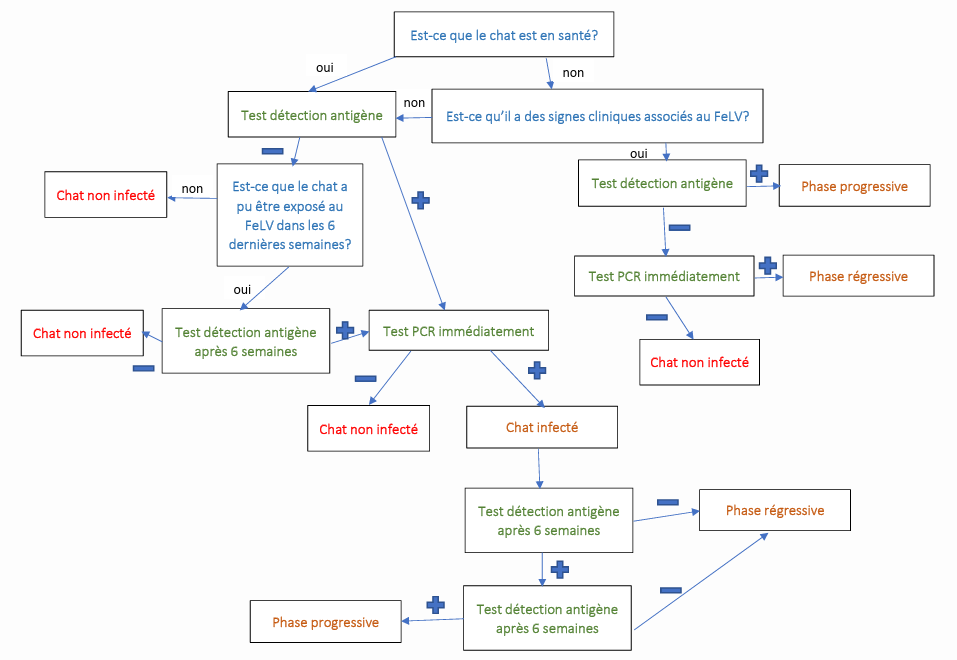Introduction
Feline immunodeficiency virus (FIV) and feline leukemia virus (FeLV) are two of the most common retroviruses in cats. These infectious diseases cause immune disorders, severe secondary infections and, in the case of FeLV, neoplasia. This article aims to provide general practice veterinarians with a thorough understanding of diagnostic methods, management protocols and preventive practices for cats with FIV and FeLV.

What is a retrovirus?
Retroviruses, such as FIV and FeLV, are RNA viruses that use reverse transcription to integrate into host DNA. Once integrated, the virus persists in the cat’s cells, causing chronic infections. These infections are difficult to eradicate, requiring long-term care and management.
Diagnosis of FIV and FeLV
Early diagnosis is essential to improve the quality of life of cats infected with FIV and FeLV. Several diagnostic tools are available to detect these infections.
Diagnostic tests for IVF
– SNAP Test: Detects anti-IVF antibodies.
– ELISA: Test used to confirm the presence of anti-IVF antibodies.
– Western blot: Confirms the presence of antibodies for each viral protein.
– PCR: Search for the provirus embedded in DNA, particularly useful for confirming infection.
Diagnostic tests for FeLV
– SNAP Test: Detects FeLV antigens.
– ELISA and IFA: Detect antigens in infected white blood cells.
– PCR: Confirms integration of the virus in the cat’s DNA.
Clinical signs of FIV and FeLV
IVF: Stages and symptoms
FIV-infected cats present three main clinical stages:
- Acute phase: fever, depression, lymphadenopathy.
- Latent phase: Cats may remain asymptomatic for years.
- Terminal phase: Recurrent infections, weight loss, anemia, and chronic bacterial infections. Neurological complications such as encephalopathy may also occur.
FeLV: Symptoms
FeLV is associated with a range of symptoms including :
– Immunosuppression: Increased susceptibility to opportunistic infections.
– Anemia: often due to bone marrow depression.
– Lymphomas: located in organs such as the thymus, liver and intestines.
– Neurological complications and liver disease.
Managing FIV+ and FeLV+ cats
IVF management
Cats with FIV require regular monitoring and specialized care to limit secondary infections. Key recommendations:
– Indoor living to avoid fighting with other cats and limit propagation.
– Nutrition: Avoid raw food to minimize the risk of further infections.
– Bi-annual veterinary examination: Early detection of complications.
FeLV management
Cats infected with FeLV must also be monitored regularly. Bi-annual examinations are recommended to assess symptoms related to immunosuppression and detect any tumors.
Vaccination and Prevention
FeLV prevention
Vaccination against FeLV is strongly recommended for cats with access to the outdoors or living in a community with other cats. This helps prevent transmission, especially in shelters and multi-cat households.
FIV vaccination
FIV vaccine is available, but its use is controversial. It is advisable to assess the risks and benefits on a case-by-case basis, especially for cats living outdoors or in high-risk environments.
Conclusion
FIV and FeLV are chronic diseases requiring rigorous veterinary management. As a veterinarian, it is essential to make cat owners aware of the risks, the importance of early diagnosis, and prevention through vaccination. By ensuring regular medical follow-up, affected cats can live long lives with improved quality of life.


